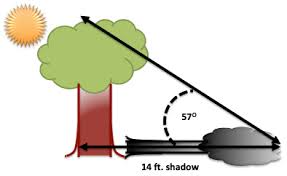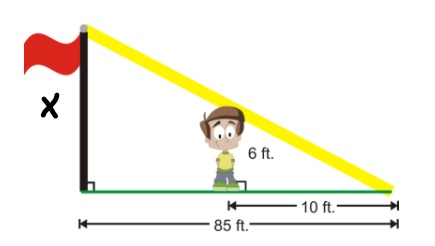Similar Triangles from Shadows

Keeping Cool With Shadows
The following excerpt is pulled from "Keeping Cool With Shadows", which was published on June, 29, 2010 at NASA.gov:
You might not always notice it. But when you're in the sun, your shadow is often nearby. It may be in front of you or behind you. Or it may be to your side. Wherever it is, your shadow looks like you and moves like you.
Two things are needed to make a shadow. The first is light. The second is something that blocks the light. Together, these two things make an area that is darker than what is around it. This area is called a shadow.
Outside, people make shadows when they block light from the sun. Think about what happens when the sun is behind you. Your body blocks some of the sun's light, causing a shadow to form in front of you. The shadow takes on the shape of your body.
When the sun is in front of you, the shadow forms behind you. If the sun is to your left, then the shadow forms to your right...The position of the sun affects the size of a shadow. A person or object blocks more light when the sun is low in the sky. More blocked light makes shadows longer. Less light is blocked when the sun is high in the sky. This makes shadows shorter.
Notice the right triangle that is formed by the tree, its shadow, and sun's ray.
In the image below, the 57 degree angle is called the angle of elevation to the sun.

Examine the similar triangles created by shadows from the sun.
The yellow lines represents the sun's rays. BC is the shadow from AB and EF is the shadow from DE.
Move points A and D to adjust segments AB and DE. Use the green slider to adjust the angle of elevation to the sun.
Similar Triangles Applet
Proportional Reasoning in Action!
What if you wanted to measure the height of a flagpole using your friend Tim? He is 6 feet tall and his shadow is 10 feet long. At the same time, the shadow of the flagpole was 85 feet long. How tall is the flagpole?
Recall, the image below shows TWO similar triangles. Use proportional reasoning to determine x.
